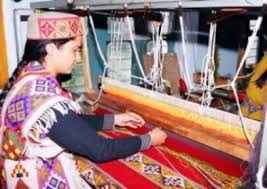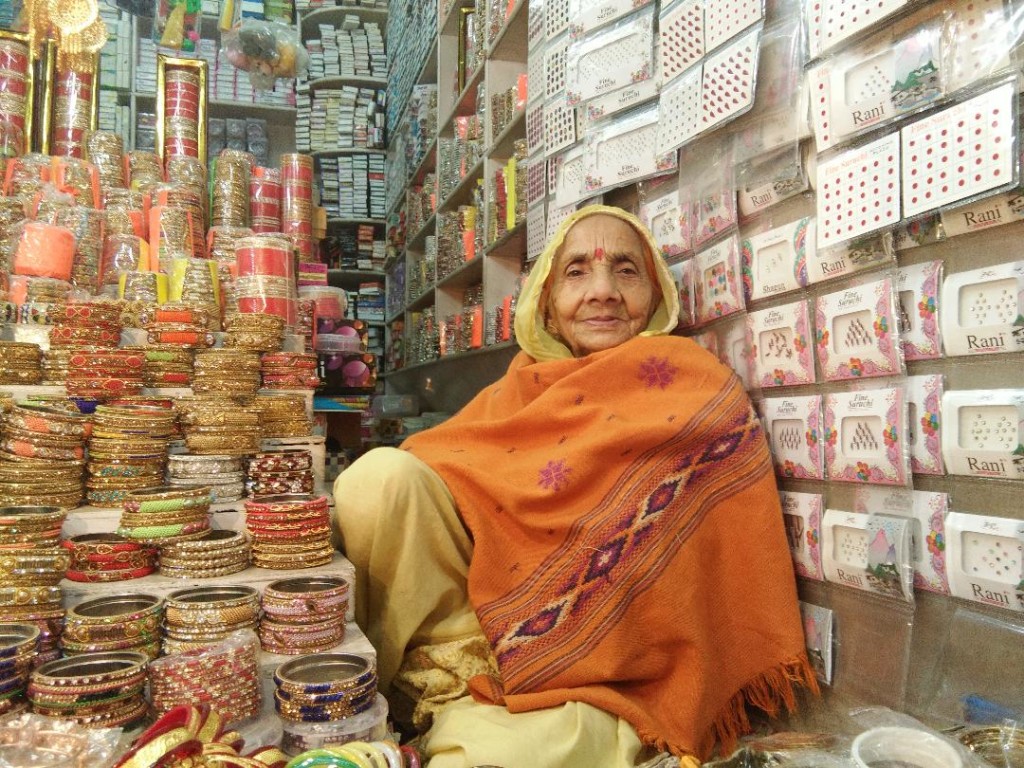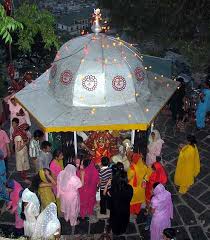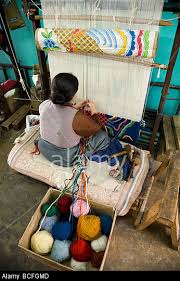Women: Custodians and Income generators of Himachal Back
ICH-INTACH Conference – ‘Himalayan Heritage – Community led economic Regeneration’
Women: Custodians and Income generators of Himachal
Maalvika Pathania
HP State Convener INTACH
Govind Bhawan Jassur. District Kangra HP.
Ph.9418464453, 9816154453
Introduction
“Women are worthy of worship. They are the fate of the household, the lamp of enlightenment for all in the household. They bring solace to the family and are an integral part of the dharmic life. Even heaven is under the control of women. The gods reside in those households where women are worshipped and in households where women are slighted all efforts at improvement go in vain.” 1/ Manusmriti 3-56.
Himachal or the land of the Gods, finds its earliest mention in the Puranas. Even today it is a repository of rich traditions, values and culture. Himachal has a vast plethora of geographical diversity which despite its variation, also acts as a binder socially and culturally. The fascination is thus in the vividness of cultural bonding that comes from the Buddhist monasteries in the Trans Himalayan areas to the lower plains much revered for its Shakti Piths , the Gurudwaras and Mosques in the State where all visit with the same fervour and awe and participate in every activity together.
Of the 51 Shakti piths or the temples known as the seat of the Goddess five are in Himachal. As she is revered as the super power who bestows health, wealth and prosperity and is worshipped as Prakriti or mother nature, she is a natural connect with women in Himachal. She is always dressed in red which also is a very popular colour with the women. They worship her in every form. It is with her in mind that they perform all their duties in the rural areas. Her personification is emulated in the women in Himachal, who are worshipped as her embodiments from childhood..Kanya puja is a sanctified traditional practise in most parts of North India. Born tough. Small in build, nimble on their feet and mentally very strong, they can tread miles with heavy loads on their backs without complaints singing songs in praise of the Goddess. The men too willingly support the women who with all fervour to carry this legacy forward.
This beautiful lyrical sloka from the Athravaveda clearly states that the woman leads the man: “The sun god follows the first illuminated and enlightened goddess Usha (dawn) in the same manner as men emulate and follow women.” 2/ Athravaveda Samhita, Part 2, Khand 27, sukta 107, sloka 5705
The Custodians
Women, as in all parts of the world here too, play a major role as custodians of the intangible heritage by insuring traditional values in the families. They have risen above many odds of geographical and religious barriers to overcome and sustain themselves and their identities and created a place of pride for themselves. They have diligently evolved and yet sustained their ethical and cultural identity. It is they who even today take pride in showcasing their ethnicity, be it social or religious. Even today they have sustained the area identity cohabiting it with religious and modern education.
The ratio of population is 51% men and 49%women with a ratio of 974 women to 1000 male. Yet it was only after the third World Conference on Women in Nairobi in 1985 that the general approach in development strategy moved from Women in Development to Gender and Development all over the country and this helped Himachal too. It further moved focus on statistics on women and men and efforts to understand and take into consideration their different role in society which was initiated by all relevant agencies.1
Earlier the woman of the house, as in any other rule of the land was the most important decision maker for the family. By virtue of being a Jeysthagrahni of the house she was also the final decision maker. These old traditions still hold sway, yet in many spheres due to our own neglect of traditional values and attacks by foreign cultures which forced women to go into the Purdah, the domination of thought moved her role to that of passive submission and complacency. Yet the economy in the hills, due to various factors remained largely managed by the women. She got into a multifaceted role of a wife, mother, agriculturist, horticulturist and any other such requirement with ease. She managed the produce from the land, wool from the sheep and education of the children, care of the elders and yet all her religious and social commitments too were met in time. This sustainability of her role got further enhanced through education.
Education and Economy
An important aspect of women sustaining the economy was the rise in the literacy rate that came into place. Where in 1951 this was just 4.8 %( male 7.5 and female 2 %) it was 83.87% by 2011(male 90.83% and female 76.6%).2
Education opened many areas of work in the organised and the non organised sector. Yet with a large population of women living in the rural areas traditions and traditional craft remained alive as an economic standby. Handicrafts of Himachal are an integral part of our economic mainstay and also help retain the cultural connect within the people of the State. Himachal has a vast plethora of geographical diversity which despite its variation, also acts as a binder socially and culturally. This cultural bonding showcases itself in all the Handicrafts that we produce in Himachal. Most local and traditional Handicrafts are wool based. Caps, mufflers, coats sweaters, dresses, shawls, woollen trousers, stoles and socks all showcase a wide spectrum of colour.
In the Brihadaranyaka Upanishad an entire lineage of about fifty teachers bear the names of their mothers as their last names, to denote that men derive their greatness from their mothers since they influence their early development.3/ V.Jayaram.Today this has once again happened in Himachal. The name of the mother in birth and death certificates, on the ration cards has given a dignity to women. Major changes in revenue laws and representation in local bodies has also helped women formulate schemes and agenda which is women centric and helps her to gain economic stability.
The common factor is that, as women, they are all constrained by ‘the norms, beliefs, customs and values through which societies differentiate between women and men’ (Kabeer, 2000, p. 22..) A woman’s level of empowerment will vary, sometimes enormously, according to other criteria such as her class or caste, ethnicity, relative wealth, age, family position etc and any analysis. Yet today she holds the threads of development very tightly and surely in her hands in Himachal.
Tourism .. The Intangible proctor
The relative benefits of tourism development to women and men inevitably reflect the socio‐cultural norms regarding gender relations and the sexual division of labour (Apostolopoulos & Sönmez, 2001; Gibson, 2001; Harvey et al., 1995; Kinnaird et al., 1994; Long & Kindon, 1997; Scott, 1997).With time now this has opened another source of income for women. Though it is debatable both in general and in relation to specific tourism settings and it has been widely noted that women have been generally less able than men to access and benefit from tourism work and business (Apostolopoulos & Sönmez, 2001; Scott, 1997; Sinclair, 1997a, 1997b, Swain, 1995).
However, it is also now very evident that tourism can and has offered the possibility that gender roles and relationships be renegotiated (Gibson, 2001; Meethan, 2001; Sinclair, 1997a, 1997b). As Meethan too (2003) has argued that cultural change through tourism cannot simply be accounted for in terms of a shift from one state into another, but rather needs to be seen as a continuous process in terms of manifestation of social, economic and cultural phenomena among which tourism is only one element.
Further to Timothy’s (2001) call for the continuation of researchers’ delving into the socio‐cultural underpinnings that have created gender disparities in tourism, then, longitudinal studies of tourism destinations should provide particularly valuable insight into how gender relations have affected and are affected by tourism development over time.
This becomes an important aspect of economics in sustainability and craft modifications with time. For the women in Himachal these earlier studies have come in as profound game changers in economy. Tourism has carved an economic niche that is today sustaining many households by the earnings of the women. Sale and production have correlated a virtual cottage industry in the state. It has also installed a sense of pride in work production and indigenous methodology and raised the standard of living in the villages as women have paved way for higher education and better living quality for their families.
Agro-economics of Himachal
Agriculture and religion has a social and a moral connection in Himachal. Here too women of the area have worked towards the mainstay of the economy with the male members as Himachal is a rural state very dependent on horticulture and agriculture. An important aspect is the religious implications prevalent in most of the aWomen have played an ‘invisible’ role for a long period of time in the economic development of rural areas, as they have been perceived as helpmates, wives and mothers, and as generally subservient to the dominant economic work of men, both in farming and outside it (Bock 1994; Sauge`res 2002; O’Toole & Macgarvey 2003).
The motive of creating additional family income, and the need for professional activity and socialisation outside the home, rural women turned their interest to jobs that utilise ‘the knowledge and skills accumulated in the family and local community’. As farming families have turned to diversification, growing numbers of women have taken paid off‐farm employment or have engaged in non‐agricultural activity on the farm (Sauge`res 2002).An effective practise of this can be seen in Kullu where women have taken a giant leap.
Looming Large—
Handloom is a major asset and a vibrant cottage industry, which has today fully evolved into a major economic market for the state. Women all over the state are the mainstay of this industry. Let us take the aesthetics of Kullu. They constitute over 90 percent of weavers in Kullu valley and work in well‐organized women weaving cooperative societies. The Co‐operative Societies perform multiple functions from coordinating with weavers to marketing, assisting them to earn money. They earn around Rs. 5000 to Rs. 10,000 a month. The societies also run various schemes and provide gratuity and bonus money, given to the women who provides services and added to the cost of the service provided, generally as a reward for the service provided and as a supplement to the service provider’s income. They are doing all types of jobs in weaving sector whether it is a managerial job or salesmanship job. This way they are earning good wages approximately around Rs 300 per day while working in co‐operative societies. They make shawls, mufflers and stoles in various patterns and designs and sold in the markets also exported outside Kullu. According to Gannon (1994), rural tourism appears to be the most attractive field for rural women. Small‐ scale enterprises in rural tourism seem to be better suited to the reality of the countryside and the profile of women entrepreneurs. Gidarakou et al. (2000) also argue that small‐scale rural tourism businesses are the best way for women to enter the labour market. Cooperatives are an interesting form of social economy in rural regions and affect a specific category of the agrarian population: women. The social importance of cooperatives is considerable because they provide full‐ or part‐time employment to a significant number of local women who have no other job opportunities—as these are limited, if not non‐ existent, in rural areas.
Throughout the year in the hilly regions of Himachal Pradesh, people practice their age‐old skills which take place as nonstop activities of making several handicrafts. Women play dominant role in these practices and it takes months of patient work before a crafted article of rare workmanship is ready to be revealed for public appraisal. The range of crafts in Himachal is vast and shows many facets of artistic dexterity. The woollen shawls and pattus of Kullu, Bharmour and Lahaul are no less striking. The location matters little, whether situated in the valley itself, or nestling against the contours of the mountainside, virtually every homestead in these areas has a handloom which remains particularly busy during the winter months. With less work in the terraced fields, the women devote themselves to weaving the traditional shawls.
Even though the shawl is believed to be relatively recent introduction to the tradition of Himachal Pradesh, shawl weaving today is one of the most flourishing industries and a means of livelihood. For people a secondary occupation to augment and supplement their income from farming. It is an employment generation device for household women of hills. The most unique identity of the people in Himachal Pradesh is the hand‐woven costumes, which are crafted with excellent finesse. The scarves that the women wear on their heads are very popular and make significant style statements. The specially made shoes, which are made from dried grass, are the best to keep their feet warm during the cold climate. Costumes of Himachal Pradesh are mostly woven by hand and the handlooms are very popular throughout the state. Due to the cold and at times harshly cold climatic conditions, shawls are also very popular among the local people as well as the tourists. . As Kullu, Manali, Rohtang, Lahaul and Spiti, with Bharmour and Chamba valley is the prime fascination for the tourists, the tourists are also inclined towards the local handicrafts and local women feel that tourism is resulting in the growth of market for the local handicrafts. Women running their own handicraft businesses feel that they are now able to make their own decisions and not to depend upon other family members.
Pottery, Bamboo weaving and embroidery—
All the objects produced in the earlier centuries had a healthy religious connect. The mud pot cooking was considered auspicious as the food was always put before the Goddess before eating. Today we know how this slow cooking retained all the minerals and was actually nutrient. Water stored in mud vessels retained purity and coolness. These are still done in the rural areas.
Snake worship is very prominent in Himachal. She is known or referred to as Nagni Mata. Protecting from evil influences, thus as the Bamboo grooves gives shelter to snakes and becomes sacred. The bamboo which flowers is cut to provide the villages for making low costing housing and shelter. The artefacts like Paand, charoli, chaabri, tokru and many other items are still in use in the villages and are an essential part of everyday life and customs. Bamboo weaving is not restricted to any caste too as it is called Succha Kaam and anyone who learns it can weave it.
Embroidery is another mainstay. The Domukha Chamba Rumal work is today a world famous art. The women were skilled in other districts in cross stitch and fine single silk thread shawl embroidery as an economic mainstay. Chamba chappal and the foot wear in Lahaul and Spiti too have very fine thread work. The famous Sui Mata Ka mela (fair) is a fine example of the grit and courage of Rani Suinayana to bring water to the town for the welfare of the women who had to travel long distances to bring in drinking water and this fair to commemorate her sacrifice is also only for women who come from far and wide to sell their products.
Horticulture
The local tradition of offering the first produce to the Deity is still prevalent. This is generally religiously followed in all the districts at various times as per local produce. This has kept not only the families but even the communities together. The first bloom is celebrated and so is the plucked fruit. The traditional songs, dance and music is zealously profound and though there are modifications to traditional wear yet it is still in vogue during weddings and festivals. These traditions thus become a continuation of many other aspects of need such as basket weaving, local food, local cloth and much more.
Food is the panacea—Breaking bread together.
All this festivity takes on a large than life scale and the food cooked on firewood is the call of the day. The traditional way is a Teen which is dug out in the soil and then large logs of wood are used to fire it up. Big copper baltois take the top space in which all different food items, as per the place and menu, are cooked. This is known as the Dhaam. The cooks are called Boti or Syaan and those who serve are called pri-yaas. The names differ as per the districts but systems are similar. Food is always first served to the Gods and young Kanyas/ girls and then it is served to all, who sit in a straight formation of equal lines, on the floor. One is only allowed to get up if the full line has finished eating. All communities sit and eat together as a symbol of unity.
All food preparations, despite the variations in variety of all the districts have a religious connect which actually pertains to health and dietary restrictions of the area. The seasonal and festive foods too differ as per the region, yet even today are cooked all over the state as per the calendar of events. There is a rich plethora of the intangible values and traditions still being carried on in Himachal. This land of the Gods firmly lets the women enhance its rich cultural traditions and yet sustains it all as a healthy economic activity. Even good technical education that is availed by the women has made them more conscious of their inheritance of this rich cultural diversity of the state.
It is indeed a matter of pride that with the world moving into the fast lane of entrepreneurial existence, it is the women here who hold their head and heart together to keep an indispensible identity alive with their love for the cultural spaces. Nonphysical assets provide Himachal a Brand recognition, which is today an inseparable part of the rich heritage inherited from centuries. Twelve districts, each with a world of deep processional and personal knowledge yet sewn together in a collage of vibrant traditional unity as one state. Letting Prakriti define the Purush in peaceful co existence, is a way of life in Himachal.
References:
Apostolopoulos, Y. and Sönmez, S. (2001) Working producers, leisured consumers: Women’s experiences in developing regions. In Y. Apostolopoulos, S. Sönmez
Clark, T. & James, F. (1992) ‘Women owned businesses: dimensions and policy issues’, Economic Development Quarterly, vol. 6, no. 1, pp. 25–30.
Gannon, A. (1994) ‘Rural tourism as a factor in rural community economic development for economies in transition’, Journal of Sustainable Tourism, vol. 2, pp. 51–59
Himachal Pradesh Accelerating Development and sustain success in a Hill State.
Hindu Sanskriti by Swami Tejyomayananda.
Kangra Gazetteer 1924-25.
( This paper presentation was part of the INTACH-ICH Conference – ‘Himalayan Heritage: Community-led Economic Regeneration’, 29th-30th Nov 2017, Wildlife Institute of India (WII), Dehradun, Uttarakhand)



















